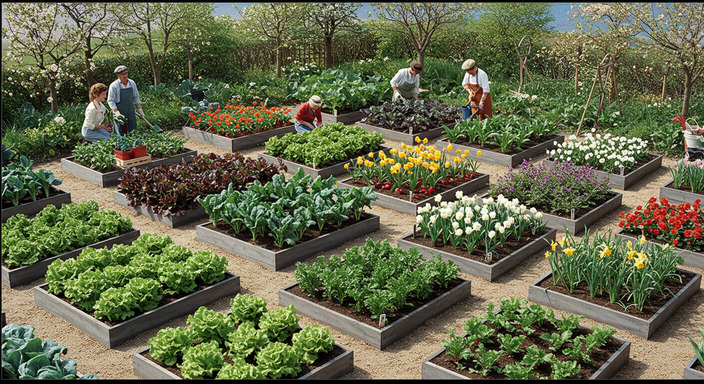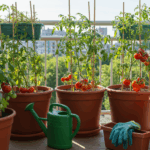The Promise of the Spring Planting Calendar
As flowers begin to bloom and birds return from their winter havens, have you ever wondered how farmers and gardeners alike know precisely when to start cultivating the earth? The secret lies within a spring planting calendar, an invaluable tool that orchestrates the changing seasons and the nature of our green landscapes. Understanding how to best use this calendar can lead to a more bountiful and environmentally sustainable harvest, enriching both our tables and our hearts.
Spring is a time of rebirth and rejuvenation, where the earth sheds its winter coat to unveil a fresh palette of colors and scents. This transformation is navigated and enhanced by the use of a planting calendar, which ensures that each seed is sown at a time when it has the best chance to grow into a thriving plant. The spring planting calendar takes into account factors such as climate, soil conditions, and regional variations, allowing gardeners to make informed decisions that align with nature’s own timeline.
Understanding Spring Planting Essentials
Before diving into the specifics of a spring planting calendar, it is crucial to understand the fundamental aspects that influence planting decisions. These aspects include temperature variations, soil readiness, and the types of crops suited to the season. Consider the following:
| Aspect | Details | Consideration |
|---|---|---|
| Temperature | Spring temperatures fluctuate | Monitor consistent warmth |
| Soil Condition | Soil thaws and dries | Check moisture levels |
| Frost Dates | Average last frost date | Plan post-frost crops |
| Crop Selection | Cold-tolerant species | Choose resilient varieties |
Ensuring each of these elements is in harmony with the environment is key to a successful planting season. For instance, monitoring soil temperature with a soil thermometer can provide insights into when it is safe to begin planting. Furthermore, understanding frost dates in your region aids in timing your planting to avoid any last-minute cold snaps that could damage young crops.
The Science Behind Planting Dates
A spring planting calendar is not arbitrary; it is rooted in agronomic science and regional climatic data. This science considers the optimal conditions for plants to germinate, grow, and resist disease. Factors such as length of daylight and soil pH also play essential roles in dictating planting times. By incorporating scientific data and trends analysis, a planting calendar becomes an efficient tool in anticipating the best outcome for each crop.
Your Guide to Seasonal Timeliness
Essential planting decisions often rely on timely action. “The farmer has to be an optimist or he wouldn’t still be a farmer,” quoted Will Rogers. Agricultural timeliness is planned precision, balancing between hopeful anticipation and environmental changes.
A carefully curated planting calendar becomes the farmer’s compass, guiding every move from sowing the first seed to reaping the harvest. Recognizing the need to align one’s agricultural clock with the seasonal beat is foundational for successful farming and gardening practices.
Navigating Regional Differences
While the principles of a planting calendar may be universal, its application must be customized to fit local circumstances. Factors such as altitude, proximity to water bodies, and specific regional weather patterns can significantly impact planting decisions. Understanding these regional nuances is crucial for optimizing the planting and harvesting of crops.
1. Identify your USDA Hardiness Zone.
2. Adjust planting dates based on altitude effects.
3. Utilize microclimate advantages for early plantings.
4. Leverage local agricultural extensions for personalized advice.
By focusing on these regional aspects, gardeners can tailor their planting calendars to match their unique environmental circumstances, leading to a more productive growing season.
Maximizing Crop Yields
The ultimate goal of adhering to a spring planting calendar is to maximize yield potential. Proper timing in planting not only guarantees healthier plants but also optimizes the output per area of land cultivated. When crops are planted at the correct time, there is less need for interventions using chemical fertilizers or pesticides, which can have detrimental effects on the environment. The result is more sustainable and eco-friendly agricultural practices.
The Art of Companion Planting
With precision in planting dates comes the ability to explore companion planting, which involves sowing crops that benefit one another. This method can extend the benefits of a spring planting calendar, creating synergies between different plant species that enhance growth, pest resistance, and yield.
For example, planting carrots and onions together can deter pests that negatively impact both crops. Similarly, the same principle can be applied to a variety of plant pairings, demonstrating the significant potential of managing a spring planting calendar with an eye towards ecological compatibility.
Economic and Environmental Impact
Utilizing a spring planting calendar effectively can lead to considerable economic and environmental benefits. Economically, it reduces waste and maximizes resource utilization—ensuring that investment in seeds, water, and labor yields the best possible return. Environmentally, it encourages biodiversity and reduces the reliance on artificial growth stimulants. This practice not only helps farmers but also contributes to the broader sustainability goals by encouraging eco-friendly farming practices.
FAQ – Common Questions
What is a spring planting calendar?
A spring planting calendar is a schedule that guides when to plant specific crops based on seasonal and regional climatic conditions.
How do I know my planting zone?
Planting zones are determined by USDA Hardiness Zones, which can be found through local agricultural extensions or online databases.
Why is timing so important in a spring planting calendar?
Timing ensures that seeds are sown under optimal conditions, resulting in higher yield and healthier plants with reduced pest problems.
Can I plant all crops at the same time?
No, it is essential to plant different crops at times suited to their specific growth needs and environmental conditions.
How can a planting calendar help with pest management?
By aligning planting dates with growth cycles, a calendar can minimize pest impact and reduce the need for chemical interventions.
Conclusion
In weaving together the myriad threads of climate, soil, and crop requirements, the spring planting calendar emerges as an essential guide for those involved in agriculture and gardening. By adhering to the guidelines and employing the strategies outlined, growers can enhance the sustainability and productivity of their efforts, reaping rich rewards from our shared planet. As we embrace the promise of spring, let us also embrace the knowledge that a well-understood calendar is key to a thriving garden or farm and, by extension, a thriving community.
Meta Descrição: Discover how a spring planting calendar optimizes your garden’s yield by aligning with nature’s rhythms, ensuring sustainable and bountiful growth.







